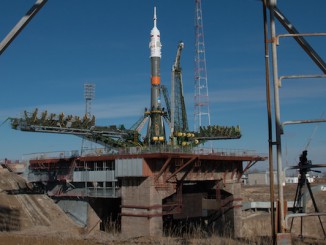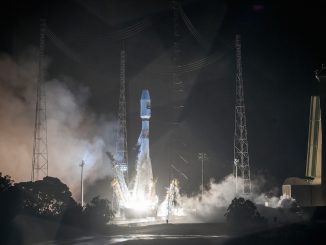STORY WRITTEN FOR CBS NEWS & USED WITH PERMISSION

Two astronauts ventured outside the International Space Station Friday for the first of four spacewalks to repair a $2 billion cosmic ray detector, breezing through work to prep the device for invasive surgery to splice in new coolant pumps and extend the instrument’s life probing the composition of the universe.
“We’re going to perform what could be considered open heart surgery on this amazing experiment,” said Italian astronaut Luca Parmitano, the current space station commander.
The 7.5-ton patient in this case is the Alpha Magnetic Spectrometer, or AMS, the most expensive science instrument aboard the space station and one that was not designed to be serviced in orbit. As such, the “operation” is considered one of the most challenging since work to repair and upgrade the Hubble Space Telescope.
“It’s definitely towards the top of the list, if not on the top,” said Tara Jochim, the AMS repair manager at the Johnson Space Center in Houston.
Floating in the station’s Quest airlock, Parmitano and NASA astronaut Drew Morgan switched their spacesuits to battery power at 6:39 a.m. EST to officially kick off the year’s ninth spacewalk.
The last time Parmitano walked in space in July 2013 his suit malfunctioned, flooding his helmet with water and forcing an emergency return to the station’s airlock. NASA developed procedures to prevent a recurrence and no similar problems have occurred since then.
The major objectives of Friday’s spacewalk were to prep the AMS for its planned surgery, setting out tools and equipment before removing a protective debris shield, giving them access to the instrument’s thermal control system.
After carefully tossing the debris shield overboard, the spacewalkers attached two handrails to help them move about the device and, reaching into the AMS, snipped a half dozen zip ties and cut a cord to fold back insulation blankets.
The work went much faster than expected and the astronauts were able to work through several items originally planned for their second spacewalk next Friday. That’s when the actual repair work will begin. The third and fourth spacewalks will be officially scheduled after managers assess the results of the first two outings.
Parmitano and Morgan returned to the airlock, closed the hatch and began repressurizing at 1:18 p.m. to wrap up a six-hour 39-minute spacewalk, the 222nd since the station assembly began in 1998, the ninth so far this year, the third for Parmitano and the fourth for Morgan.
“I’ve got to tell you, you made the ground team awfully happy and proud of you guys today, just some excellent, excellent work,” Canadian astronaut Jeremy Hansen radioed from mission control. “We are very, very pleased with where we stand moving forward, getting the Alpha Magnetic Spectrometer back up and running. So congratulations to all of you.”
Unlike the Hubble Space Telescope, designed from scratch to be serviced by spacewalking astronauts, the Alpha Magnetic Spectrometer was never intended to be worked on in space. As such, it was not equipped with the sorts of fasteners, cables, handrails and internal clearances needed by astronauts working in bulky, pressurized suits.
In the end, it took engineers and astronauts four years to come up with a workable plan, developing some two-dozen custom tools and testing procedures during multiple underwater training runs. Parmitano and Morgan completed seven full-duration training exercises before launching to the station in July.
“We had to go off and figure out how to create a work site, we had to build new handrails to install on existing hardware, we had to deal with existing sharp edges and in a lot of cases, we’re creating new sharp edges using tools that have sharp edges on them,” said Jochim.
“We did as much as we could to minimize that risk to the crew member and then, of course, to the (repair) of the payload itself,” she said. “But they are certainly very challenging and technically difficult EVAs.”
Launched in 2011 on the next-to-last space shuttle mission, the Alpha Magnetic Spectrometer, is one of the most expensive science instruments ever launched.
It is built around a powerful electromagnet that bends the trajectories of electrically charged cosmic ray particles created in supernova explosions and other extreme-energy events, allowing researchers studying the trajectories to characterize their velocities and energies.
The goal is to learn what happened to the antimatter thought to have been created in the big bang birth of the cosmos, to learn more about the unseen dark matter that permeates space and, possibly, gain insights into the nature of dark energy, the mysterious repulsive force that is speeding up the expansion of the universe.
Designed to operate for just three years, the AMS proved longer lived than expected, detecting more than 145 billion cosmic rays during eight-and-a-half years of operation. But the instrument has been hobbled in recent months by the staggered failures of four small pumps needed to circulate carbon dioxide coolant through its sensitive detectors.
To repair the AMS, Parmitano and Morgan will have to cut through eight small coolant lines during their second spacewalk and splice in, or “swage,” new lines leading to a custom-built replacement pump module launched to the station earlier this month. The pump module will be installed during the third spacewalk.
“We’re going to cut tubes, and then fuse them with other tubes (launched) from Earth and install a completely new pump to help the refrigeration work, keeping the magnet cold so the the Alpha Magnetic Spectrometer can work,” Parmitano said. “This is really the first time any of these actions have been attempted.”



